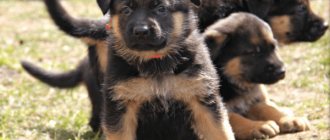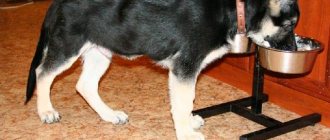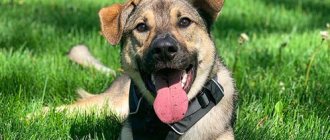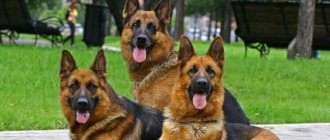In order for a German Shepherd to become a true service dog, a companion and a reliable assistant to a person, it must be properly raised and trained. The process is not easy, it requires perseverance and perseverance. Having purchased a German Shepherd puppy at the age of 1 month, you should be prepared to invest a lot of time and effort into its development before you can raise a loyal and devoted friend with a balanced character. The set goals will be achieved if you know the developmental features of a German at any age, properly maintain and lovingly care for him.
Description of the German Shepherd breed
The German Shepherd as a breed appeared in Germany at the end of the 19th century. The dogs are large, weighing up to 40 kg for males and 32 kg for females. The height at the withers of an adult male is 65 cm, the female is 5-7 cm lower. The dogs are built harmoniously and proportionally, their body is slightly elongated, muscular, strong, and their bones are not rough. The head is wedge-shaped, moderately wide in the area of the ears. The forehead is convex, the stop is smooth. The neck is mobile, strong and graceful. The eyes are dark, oval and slightly slanted. The jaws are well developed, the teeth are strong, and the bite is scissor-type. The ears are large, erect, directed forward. The chest is voluminous, the back line is flat, with a slight slope from the withers to the croup. The tail is lowered, slightly curved, long. The limbs are straight, strong, parallel.
The coat is thick, dense, with high-quality undercoat. Color black, tan, zoned grey. The German Shepherd has a dark mask on its face and a saddle cloth on its back.
The character of the German is friendly and lively. The intelligence is high, the breed is focused on serving people, it is easy to train and train.
Is a pedigree necessary?
It is quite possible to buy a good puppy without a pedigree, which will be an excellent companion and guardian for the family. However, you need to understand that buying a dog without documents is always a lottery. There is no guarantee that a puppy will exhibit all the qualities inherent in German Shepherds. The situation with hereditary diseases in such dogs may also not be happy. Often, in an effort to get more litters from one bitch, a dog is bred more than once a year. As a result, the offspring are weak and sickly.
Often, puppies are sold to inexperienced people - a mix of a German shepherd and some large mongrel. It is not so easy to distinguish a purebred puppy at the age of 1.5-2 months from a half-breed.
When purchasing a shepherd dog from a kennel with a good reputation, the owner receives a guarantee of the health and stable psyche of the baby’s parents. In kennel clubs, dogs are selected for mating with special care, and the offspring are evaluated from birth. Sick and non-compliant individuals are discarded.
A purebred German Shepherd from a serious breeder cannot be cheap. The price of a puppy starts from 20,000 rubles. and reaches 50,000. This range in cost is due to the different class and purpose of the dogs:
- There are German Shepherds that have good pedigree and good health, but have minor defects (too short or too tall, malocclusion, color errors) that do not allow them to attend exhibitions or participate in breeding. Breeders classify such shepherd dogs as the pet class. These dogs are cheaper, but will become wonderful companions, guards and simply beloved pets.
- To attend exhibitions, you will have to purchase a show-class puppy. These are the best representatives of the breed, meeting all strict selection criteria. As a rule, the litter of even the most titled parents produces only a couple of show-class puppies.
- The breeding class includes German Shepherd females that are intended for breeding. These representatives of the breed must not only fully comply with the standard, but also have excellent health. Particular attention is paid to the absence of inherited diseases over several generations.
Many owners seek to purchase a dog to protect their home and family members. In this case, you should pay attention to the kennels of the Ministry of Internal Affairs, where working German shepherds are bred. The strict selection carried out there and constant work with dogs guarantees that the best qualities of German shepherds are fixed in the offspring: obedience, courage, endurance.
How many months should ears stand?
Small puppies' ears look disproportionately large. From 2 months to 4 months of age, the German Shepherd's body actively produces elastin and collagen, so the ears grow much faster than other parts of the body. They become heavy and large. From two to six months they begin to stand up - first in a “house”, “cap”, they can fall to one side, rise and fall again. By 5 months of age, the structure of the auricle reaches its maximum density, the ear stops growing and stands up completely. If this does not happen, the reason may be:
- lack of minerals in the diet;
- ear pathologies;
- weak immunity;
- the shepherd is not purebred;
- individual characteristics of the puppy.
Marriage or standard?
Small German Shepherds are not classified as a separate breed. Moreover, individuals with such a defect should be sterilized in order to prevent unplanned matings and the appearance of unwanted offspring. Dwarfism is considered a defect and a deviation from the standard. Such a dog requires more attention because there is a malfunction in his body, he cannot function normally, and this leads to the development of other pathologies. If dwarfism is detected early, a course of growth hormone injections is prescribed, which will help avoid many complications in the future.
What does a German Shepherd puppy look like and behave like?
Despite the fact that German puppies take a long time to develop and are finally formed only by the age of three, their appearance changes quickly - they gain weight and acquire the necessary skills. At first, babies are clumsy and clumsy, but later they become like adult dogs - beautiful and harmoniously built. The dog breeder should know what changes occur with the puppy throughout its growing up.
At 1 and 2 weeks
At birth, the weight of babies is 300-500 g. Girls are most often lighter than boys. During the first two weeks, puppies double their weight, begin to see, hear, and develop sense organs. At this time, they crawl on their stomachs, pushing off with their paws. In the first week, they are applied to the mother's breast up to twelve times a day. She licks the babies, stimulates their physiological functions and eats excrement.
Three week old puppy
The average weight of a small German at three weeks is 2 kg, the maximum is 2.8 kg. Changes occur in appearance - the eyes become expressive and lively. While the color of the iris remains blue. Babies feed on mother's milk, but you can start feeding them complementary foods. In the third week, the puppies get to their feet and try to walk and explore the world around them. The process of socialization begins - meeting a person and communicating with other puppies occurs.
At 1 and 1.5 months.
The height of a one-month-old puppy at the withers is from 18 cm to 22 cm, weight is from 3 kg to 4 kg. It is clearly noticeable that the chest is wide and the back is short. The ears are soft and large while hanging. The eye color gradually changes to dark brown, but in some cases remains blue for up to two months. At 1 month, a German Shepherd puppy develops a black undercoat, thick and voluminous.
At one and a half months, the “period of fear” begins, when the baby is afraid of being left alone, without his mother, and is afraid of everything new. But at the same time he strives to leave the “nest” and inspect the house.
At 3 and 5 months
At 3 months, the puppy’s weight reaches 12-14 kg, height at the withers is up to 46 cm, chest circumference is 56 cm. The ears are heavy, they begin to rise, but can fall to the side. Sometimes one stands up, the other hangs.
A baby at the age of 3-4 months cannot wait to go for a walk; he is taught to go to the toilet in a tray or in a diaper. The 28 baby teeth begin to change into 42 permanent teeth. The puppy's gums itch and he chews on everything he comes across. By the age of 5 months, the little German needs to be taught the commands “Walk!”, “Lie down!”, “Come to me!”, “Stand!”, “Place!”, “Sit!”, “No!”. The duration of classes is no more than 20 minutes per day.
At 7 and 8 months
A seven-month-old German Shepherd weighs 32 kg, height at the withers is 52-62 cm. During this period, growth stops and muscle mass increases.
The dog is trained to follow sign commands, taught to take barriers, walk on booms and move up stairs. A properly trained seven-month-old shepherd automatically takes a place at the left leg and walks nearby without a leash.
At 10 months
At the age of 10 months, the puppy's flat bones become enlarged. In males, testicular descent occurs, in females the first heat occurs. The average weight reaches 34 kg, height – 64 cm. If by this age the dog has not mastered the basic commands, you should contact a professional dog handler for further development.
At 12 months
In one year, the shepherd looks like an adult, its nervous system is finally formed, although “teenage” conflicts continue. The dog reaches its maximum height and body length, and muscle mass continues to grow for about two years.
At the age of one year, the change from puppy to adult fur is completed; its color no longer changes.
Dimensions, weight and other distinctive characteristics
This dog will weigh less than 15 kg . It is much smaller than a full-fledged animal, not only in weight, but also in other dimensions.
The height of a dwarf dog will be approximately half the height of a healthy “German”, that is, it will be approximately 29-32 cm. Also, a dwarf has a narrower chest girth, back length and shorter paws.
At the same time, the shape of the head and tail is preserved . This gives the dog a slightly disproportionate appearance.
Care and maintenance of a German Shepherd puppy by month
In order for the puppy to develop properly, be well educated and healthy, care for it must be regular and age appropriate. Caring for a German Shepherd includes the creation of living conditions, hygiene measures, regular walking and a balanced diet.
Feeding
Puppies are breastfed until 3-4 weeks. In a month, complementary foods are introduced - high-quality lean meat, kefir and cottage cheese. At one and a half months, porridge (rice and oatmeal) is added, at three months - vegetables (first boiled, later raw).
Meals should be regular with frequency:
- 6 times – for two-month-old puppies;
- 5 times – for three-month olds;
- 3 times - for six-month-olds;
- 2 times – after 10 months.
Toilet training
A German Shepherd puppy should be litter box trained immediately after moving to a new home. As soon as the dog sits in the wrong place, he is transferred to the tray. He quickly understands what the owner is trying to achieve and begins to go to the toilet in the right place.
They are taught to use the outdoor toilet after vaccinations and quarantine are completed. Walking is carried out immediately after waking up, feeding and before bedtime. Walks (at least six at first) should be distributed evenly throughout the day. As soon as the puppy has done his business, he is praised and encouraged.
Hygiene
Hygiene measures must be carried out regularly to ensure that the pet remains healthy and has an attractive appearance.
The eyes are examined once a week and, if necessary, washed with boiled water or a decoction of chamomile. If inflammation or redness is observed, contact your veterinarian.
Teeth are brushed once a month with a special powder. To get rid of tartar and plaque on enamel, bones made from leather with a high fluoride content are purchased.
Clean your ears monthly using swabs soaked in a special lotion. If a little German begins to scratch them frequently, shakes his head, and wet discharge appears from the ears, this is a reason to contact a veterinary clinic.
You should pay attention to the claws. Their ends are regularly (once every 2 months) trimmed and treated with a nail file.
Walk
The first full walk is carried out after vaccination. At first, being on the street lasts no more than 10 minutes. At two months, the dog is walked for half an hour. During this period, they are taught to use a leash. From the age of seven months, they spend at least two to three hours walking. They are engaged not only in the physical development of the pet, but also in its socialization - communication with other dogs (not homeless or stray dogs).
The best option for a pet is to live in an enclosure on the territory of a country house, where there is a place for walking, and the dog can run around freely to its heart’s content.
Vaccinations and diseases
To develop immunity in a puppy, they are vaccinated against deadly diseases:
- enteritis;
- parainfluenza;
- leptospirosis;
- plague;
- hepatitis A;
- rabies.
Vaccinations are given to absolutely healthy puppies that have been dewormed. Before vaccination, the doctor examines the animal and measures the temperature.
Vaccinated for the first time at 2 months of age. Then the German Shepherd is vaccinated at 6 months, at 1 year and then annually.
Diseases, life expectancy
The genetic defect negatively affects the health of the Miniature German Shepherd. It is often weakened, and many problems arise:
- colds;
- allergic reactions;
- infertility;
- disorders of the kidneys;
- hair loss and partial baldness;
- improper functioning of the thyroid gland;
- bacterial and viral infections;
- hyperpigmentation;
- problems with bones and joints.
The dog needs constant supervision and attention from the owner and veterinarian. To protect the little German from serious diseases, he is given complex vaccinations against parainfluenza, distemper, enteritis, hepatitis and rabies. Hormone injections are given as prescribed.
The life expectancy of dwarf shepherd dogs is short - only 4-5 years, and only under the condition of proper and high-quality care for them.
How to distinguish a purebred from a crossbreed?
It is easier to determine whether a puppy is purebred if it is 2 months old. A real German Shepherd has a topline without breaks or humps, starting from the withers to the base of the tail. If the dog's body is square, it is a crossbreed.
The German's movements should be smooth, easy, without stiffness. There are no skin folds on the head of a purebred shepherd dog, its nose is black, its jaws are strong, the lines of its forehead and muzzle are parallel. The ears are erect, directed forward, the tips are slightly bent back. The tail should be long, even, without kinks. If it is short and hooked, it is a mixed breed.
Where can I buy a puppy?
You need to buy a puppy from a professional kennel that breeds German shepherds. It is there that specialists work who select pairs for mating, taking into account the heredity of the individuals. Some of the most famous nurseries in the Russian Federation:
- “Team Zilber Wasserfall” – Vladimir region, Kolchugino.
- “From the Blue Star” - Moscow.
- "Haus Schiran" - Moscow region.
- "Shvalbennest" - Khabarovsk.
- "Samara Land" - Samara.
- “De Orse Mak Flai” – Moscow region, Vyalki village.
History of origin and appearance in the photo
"German" dwarfism is a genetic defect . It is called "pituitary dwarfism" or pituitary dwarfism syndrome.
The disease is inherited. It lies in the fact that the pituitary gland stops producing growth hormone, this is transmitted to a recessive gene.
The appearance of dwarf animals in the offspring suggests that both parents accidentally became carriers of such a gene.
Miniature German Shepherds are not allowed to breed.











